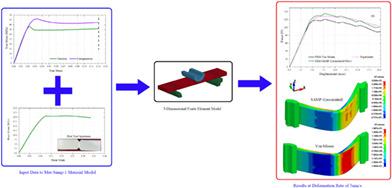当前位置:
X-MOL 学术
›
Polym. Eng. Sci.
›
论文详情
Our official English website, www.x-mol.net, welcomes your feedback! (Note: you will need to create a separate account there.)
Experimental and numerical investigation on flexural behavior of acrylonitrile‐butadiene‐styrene polymer
Polymer Engineering and Science ( IF 3.2 ) Pub Date : 2020-09-10 , DOI: 10.1002/pen.25524 Mehmet Akif Dundar 1 , Gurpinder Singh Dhaliwal 1 , Emmanuel Ayorinde 1
Polymer Engineering and Science ( IF 3.2 ) Pub Date : 2020-09-10 , DOI: 10.1002/pen.25524 Mehmet Akif Dundar 1 , Gurpinder Singh Dhaliwal 1 , Emmanuel Ayorinde 1
Affiliation

|
Acrylonitrile‐butadiene‐styrene (ABS) is an extensively utilized rubber‐toughened amorphous thermoplastic in industry. Compared to other amorphous thermoplastics, the most promising mechanical quantity of ABS is its high impact resistance. Thus, understanding the mechanical response of ABS to multiaxial loads is of the great industrial concern. The primary objective of this study was to characterize the flexural response of ABS by conducting three‐point bending tests at two distinct deformation rates of 5 and 10 mm/s to figure out the deformation rate effect on the flexural response of ABS. It was observed that the ABS act stiffer with an increased deformation rate. Numerical implementation of three‐point bending tests for each deformation rate was performed using the semi‐analytical material model (SAMP‐1) available in Ls‐Dyna finite element code. The simulations for each deformation rate were run depending on SAMP‐1 and Von‐Misses yield surface formulations to figure out the effect of nonidentical material behavior of ABS in tension, compression, and shear on flexural response. The percentage error in the predicted peak force values considering the compression and shear test data (SAMP‐1) and without it (Von Misses) was 3% and 7% for deformation rate of 5 mm/s and 5% and 12% for deformation rate of 10 mm/s. Hence, predicting the flexural behavior of ABS accurately, dissimilar material behavior needs to be taken into consideration. Moreover, associated and nonassociated flow rule effects on the flexural response of ABS were numerically investigated and there was no significant influence observed on the flexural response of ABS.
中文翻译:

丙烯腈-丁二烯-苯乙烯聚合物弯曲行为的实验和数值研究
丙烯腈-丁二烯-苯乙烯(ABS)是工业上广泛使用的橡胶增韧无定形热塑性塑料。与其他无定形热塑性塑料相比,ABS最有希望的机械用量是其高抗冲击性。因此,了解ABS对多轴载荷的机械响应引起了极大的工业关注。这项研究的主要目的是通过在5和10 mm / s的两个不同形变速率下进行三点弯曲测试来表征ABS的挠曲响应,以找出形变速率对ABS挠曲响应的影响。可以观察到,ABS的刚性更高,变形率也更高。使用Ls-Dyna有限元代码中可用的半分析材料模型(SAMP-1)对每种变形率进行三点弯曲测试的数值实现。根据SAMP-1和冯·密斯(Von-Misses)屈服面公式对每种变形速率进行了模拟,以求出ABS在拉伸,压缩和剪切过程中材料特性不同对弯曲响应的影响。考虑到压缩和剪切试验数据(SAMP-1)以及没有压缩和剪切试验数据(Von Misses)的预测峰值力值的百分比误差,对于5 mm / s的变形率,分别为3%和7%,对于变形率,分别为5%和12%速度为10毫米/秒。因此,要准确地预测ABS的弯曲行为,就必须考虑不同的材料行为。此外,数值研究了相关和非相关流动规则对ABS挠曲响应的影响,没有观察到对ABS挠曲响应的显着影响。
更新日期:2020-11-12
中文翻译:

丙烯腈-丁二烯-苯乙烯聚合物弯曲行为的实验和数值研究
丙烯腈-丁二烯-苯乙烯(ABS)是工业上广泛使用的橡胶增韧无定形热塑性塑料。与其他无定形热塑性塑料相比,ABS最有希望的机械用量是其高抗冲击性。因此,了解ABS对多轴载荷的机械响应引起了极大的工业关注。这项研究的主要目的是通过在5和10 mm / s的两个不同形变速率下进行三点弯曲测试来表征ABS的挠曲响应,以找出形变速率对ABS挠曲响应的影响。可以观察到,ABS的刚性更高,变形率也更高。使用Ls-Dyna有限元代码中可用的半分析材料模型(SAMP-1)对每种变形率进行三点弯曲测试的数值实现。根据SAMP-1和冯·密斯(Von-Misses)屈服面公式对每种变形速率进行了模拟,以求出ABS在拉伸,压缩和剪切过程中材料特性不同对弯曲响应的影响。考虑到压缩和剪切试验数据(SAMP-1)以及没有压缩和剪切试验数据(Von Misses)的预测峰值力值的百分比误差,对于5 mm / s的变形率,分别为3%和7%,对于变形率,分别为5%和12%速度为10毫米/秒。因此,要准确地预测ABS的弯曲行为,就必须考虑不同的材料行为。此外,数值研究了相关和非相关流动规则对ABS挠曲响应的影响,没有观察到对ABS挠曲响应的显着影响。


























 京公网安备 11010802027423号
京公网安备 11010802027423号